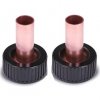John Vegas
Member
Falcon
It seems very difficult to find a 1-inch push on fitting. Loads of 3/4-inch. GRRR!
JS
It seems very difficult to find a 1-inch push on fitting. Loads of 3/4-inch. GRRR!
JS
That is going to be a tough sale.
You will do great with a new system, parts availability will be much easier in the future. All of the Fleck valves have solder connectors available. The 5600 style has 3/4" - 1-1/4", the 7000 has 3/4" to 1-1/2" available. You could use the Falcon x John Guest View attachment 17710 with the MIP connectors that are standard on most Fleck systems as well. Good luck!

